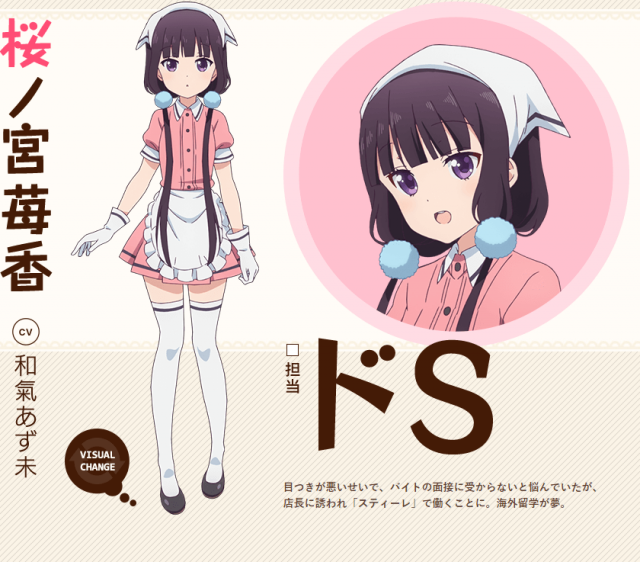"Cells at Work!", an anime series that began airing in July 2018, is a comical depiction of the cells that thrive in the human body, but it also features a wide variety of cells that exist within the body.

Source: Cells at Work © Shimizu Akane/Kodansha, Aniplex, davidproduction
Each cell is unique and captivating. This is a fascinating and easy-to-understand way to learn about the internal workings of the body, making it a fun and useful study tool.
In this article, we will introduce the charms of the characters that appear in "Cells at Work!"
1. Red Blood Cells
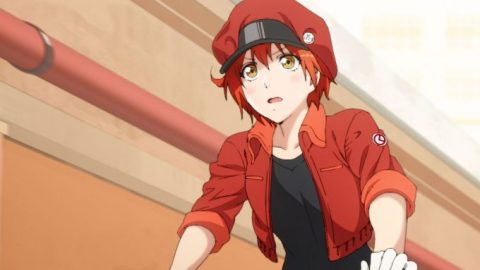
Source: Cells at Work! © Shimizu Akane / Kodansha, Aniplex, davidproduction
Red blood cells, rich in hemoglobin, have the primary role of transporting oxygen to cells throughout the body and carbon dioxide to the lungs through blood circulation. The female red blood cell, who serves as the protagonist, is a novice courier.
He often gets lost
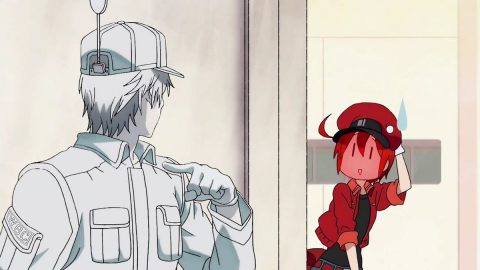
Source: Cells at Work! © Akane Shimizu/Kodansha, Aniplex, David Production
Even though his job is to transport oxygen and carbon dioxide, this character often gets lost. He gets lost even while looking at a map, so he could be said to be born with a poor sense of direction.
Persevering to the End

Source: Cells at Work! © Akane Shimizu/Kodansha, Aniplex, David Production
Although he may not be a skilled red blood cell, he has a greater sense of responsibility for his work than most. Even when his body was in dire straits due to hemorrhagic shock, he continued to diligently deliver oxygen to cells.
2. White Blood Cells (Neutrophils)

Source: Cells at Work! © Akane Shimizu/Kodansha, Aniplex, David Production
White blood cells are responsible for eliminating bacteria and viruses that invade the body. Among them, neutrophils, the protagonists, are cool and diligent in their work. They are also caring, and will help red blood cells when they're in trouble.
You can tell what kind of bacteria it is by eating it

Source: Cells at Work! © Shimizu Akane / Kodansha, Aniplex, David Production
White blood cells have the ability to break down bacteria by ingesting them. That's why neutrophils also crunch on cedar pollen allergens.
Moving Smoothly Through Chemotaxis
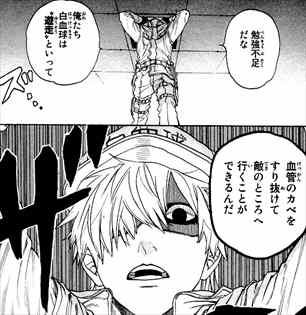
Source: Cells at Work! © Akane Shimizu/Kodansha, Aniplex, David Production
White blood cells can move freely within tissues through a process known as chemotaxis. This ability allows them to quickly rush to the aid of bacteria, no matter where they are.
Ruthlessly Eliminate Bacteria
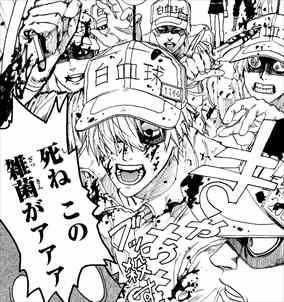
Source: Cells at Work! © Akane Shimizu/Kodansha, Aniplex, David Production
When neutrophils find bacteria or viruses, they instantly go berserk and ruthlessly eliminate them. Their frantic attack on bacteria earns them strange looks from other cells.
Detecting enemies with receptors

Source: Cells at Work! © Shimizu Akane/Kodansha, Aniplex, davidproduction
White blood cells detect bacteria using radar-like structures called receptors. While it's a useful feature, the design is a bit clunky.
3. Platelets

Source: Cells at Work! © Shimizu Akane/Kodansha, Aniplex, David Production
Platelets are responsible for sealing wounds when blood vessels are damaged. While they look like elementary school children, their actions and mannerisms are incredibly cute, making them a popular character in this anime.
A reliable worker in times of need
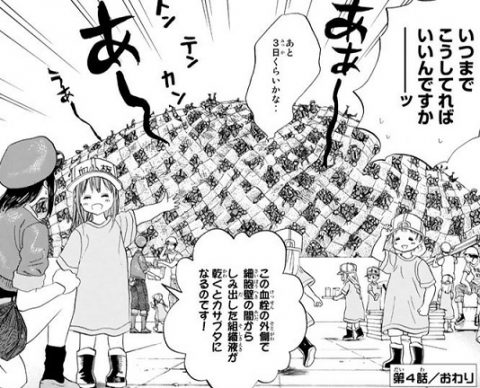
Source: Cells at Work! © Shimizu Akane/Kodansha, Aniplex, davidproduction
Platelets form blood clots to prevent bacteria from entering the body, such as when a scratch is sustained. This prevents the bacteria from invading and helps turn the tide.
They Heal Everyone
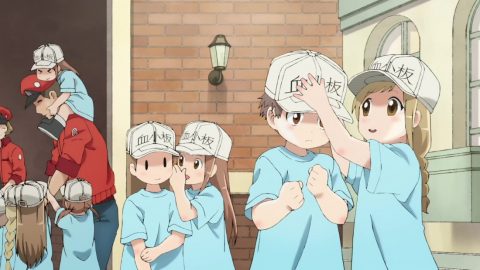
Source: Cells at Work! © Akane Shimizu/Kodansha, Aniplex, David Production
The charm of platelets is, without a doubt, their cuteness. Just watching them carry large loads with their small bodies and act together as a group is soothing to the senses.
They excel at group activities and are united.
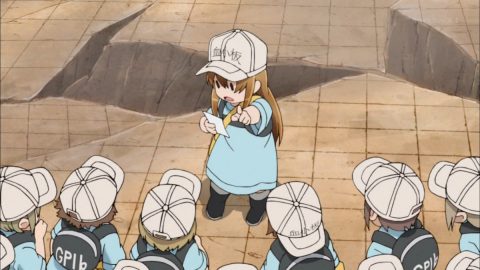
Source: Cells at Work! © Akane Shimizu/Kodansha, Aniplex, davidproduction
Platelets always work in groups. They are excellent teamworkers, and when working, they are always quick to call attention and shout encouragement. Their outstanding teamwork allows them to quickly form blood clots.
4. Killer T Cells

Source: Cells at Work! © Akane Shimizu/Kodansha, Aniplex, David Production
Killer T Cells are a type of lymphocyte that are assassins dressed in black work clothes. They are muscular and have a ferocious personality. They have an extremely high ability to kill bacteria, and upon command from helper T cells, they immediately rush to the scene and complete their tasks.
A Dropout at Thymus School

Source: Cells at Work! © Akane Shimizu/Kodansha, Aniplex, David Production
Before becoming a killer T cell, I was a dropout at Thymus School. I struggled to keep up with the others, but through hard work and the help of my peers, I was able to become a stellar killer T cell.
Memory T Cells

Source: Cells at Work! © Akane Shimizu/Kodansha, Aniplex, David Production
There are several types of T cells. Memory T cells record enemies that have entered the body and prepare for their reappearance. The book that records the enemies is adorable.
Naive T Cells
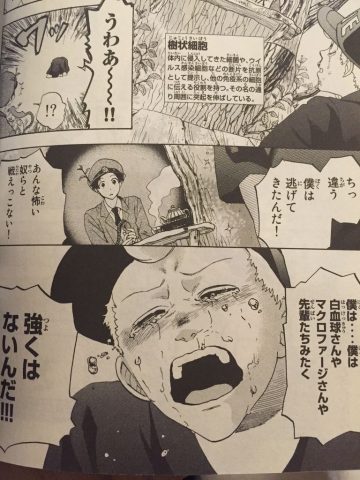
Source: Cells at Work! © Akane Shimizu/Kodansha, Aniplex, David Production
These are immature T cells that have never encountered an antigen. They were initially timid and timid, but they were activated by dendritic cells and became powerful T cells. When activated, naive T cells look completely different.
Effector T Cells

Source: Cells at Work! © Akane Shimizu/Kodansha, Aniplex, davidproduction
This is the activated form of naive T cells. They are more robust than killer T cells and can also divide and proliferate.
5. Helper T Cells

Source: Cells at Work! © Akane Shimizu/Kodansha, Aniplex, David Production
As a commander-like figure, they are responsible for informing the cells of external enemies and countermeasures. While they display a cool side, they also have a clumsy side, such as when they issue orders with cookie crumbs still stuck to their cheeks.
An elite during his thymus days

Source: Cells at Work! © Akane Shimizu/Kodansha, Aniplex, David Production
He was an elite with excellent grades at thymus school. He developed a friendship with the future killer T cell, and now they form a wonderful team.
6. Memory Cells

Source: Cells at Work! © Shimizu Akane/Kodansha, Aniplex, David Production
These lymphocytes memorize the immune system against antigens that have invaded the body in the past. While they are supposed to remember past events, they occasionally forget them, which can lead to them being mistaken for predicting the future.
Working with B Cells

Source: Cells at Work! © Shimizu Akane/Kodansha, Aniplex, davidproduction
B cells, which produce antibodies against antigens, create antibodies from antigens memorized by memory cells, so the collaboration between these two cells is crucial for eliminating bacteria.
7. B Cells

Source: Cells at Work! © Akane Shimizu/Kodansha, Aniplex, David Production
B Cells are responsible for producing antibodies against antigens. They produce antigens based on antigen information stored by memory cells, but memory cells have difficulty recalling antigen information.
8. Mast Cells
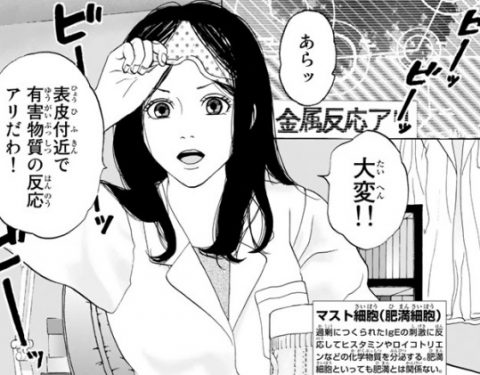
Source: Cells at Work! © Shimizu Akane/Kodansha, Aniplex, davidproduction
Mast cells secrete histamine and other substances in response to stimulation by excessive IgE antibodies. However, even though their constant histamine secretion causes problems for surrounding cells, mast cells simply believe they are doing their job.
Called a Hysterical Woman
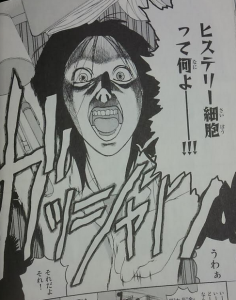
Source: Cells at Work! © Akane Shimizu/Kodansha, Aniplex, David Production
Mast cells are criticized by other cells every time they secrete histamine. If they are criticized too much, they become hysterical and enraged.
Also known as: Mast cells

Source: Cells at Work! © Akane Shimizu/Kodansha, Aniplex, David Production
Although they are called mast cells, they have no connection to obesity.
9. Macrophage

Source: Cells at Work! © Shimizu Akane / Kodansha, Aniplex, David Production
A type of white blood cell, it kills bacteria and other microorganisms, and also detects antigens and immune signals. While they may look like elegant young ladies, they have extremely high killing powers and can sometimes display spectacular slaughter.
Nurturing Erythroblasts

Source: Cells at Work! © Akane Shimizu/Kodansha, Aniplex, David Production
In addition to eliminating bacteria, macrophages also play a role in nurturing erythroblasts before they become red blood cells. They have many roles, sometimes as assassins, sometimes as nursery teachers, and more.
Monocyte

Source: Cells at Work! © Akane Shimizu/Kodansha, Aniplex, David Production
A type of white blood cell, this monocyte wears full-body protective gear. It has strong phagocytic and migratory abilities and powerful killing capabilities. It also resembles a macrophage when active outside blood vessels, creating a stark contrast in appearance.
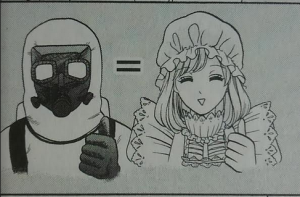
Source: Cells at Work! © Akane Shimizu/Kodansha, Aniplex, David Production
10. Dendritic Cells

Source: Cells at Work! © Akane Shimizu/Kodansha, Aniplex, David Production
Dendritic cells resemble large trees with protrusions extending outward. They present fragments of bacteria and viruses that have invaded the body as antigens and communicate them to other immune system cells. They also activate other immune system cells.
Knows everyone's past

Source: Cells at Work! © Shimizu Akane/Kodansha, Aniplex, David Production
Embarrassing photos from the cells' past are used as a means to activate immune system cells. Spreading these photos activates them.
Get Energized with Lactic Acid Bacteria

Source: Cells at Work! © Shimizu Akane/Kodansha, Aniplex, davidproduction
Dendritic cells suddenly become more energetic and their personalities change when they are supplied with polysaccharides produced by lactic acid bacteria.
Langerhans Cells
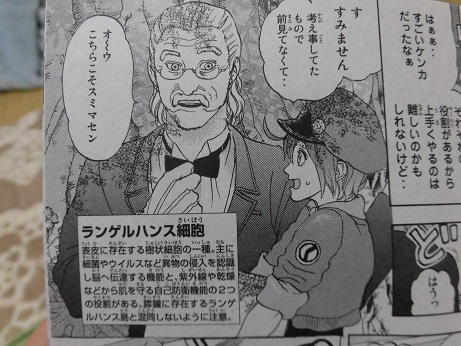
Source: Cells at Work! © Akane Shimizu/Kodansha, Aniplex, David Production
They have the appearance of a foreign gentleman. Their main functions are to alert the body to the presence of foreign substances and to prevent skin infections. They have also been infected with the dengue virus.
11. Eosinophil

Source: Cells at Work! © Akane Shimizu / Kodansha, Aniplex, David Production
A cool woman with blonde twintails. While weak against ordinary bacteria, this white blood cell is extremely resistant to parasites. He has a strong sense of justice and bravely faces even those he cannot defeat.
He's weak when praised

Source: Cells at Work! © Shimizu Akane / Kodansha, Aniplex, davidproduction
Eosinophil usually acts cool, but when everyone praises him for defeating the parasitic worm Anisakis, he can't help but grin, revealing a completely different side of himself than usual.
12. NK Cells
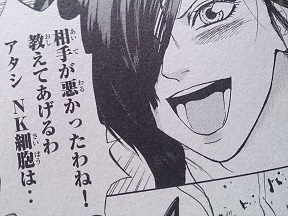
Source: Cells at Work! © Shimizu Akane/Kodansha, Aniplex, davidproduction
NK Cells are lymphocytes that patrol the body, eliminating cancer cells and virus-infected cells. She's an aggressive woman who often teases Killer T Cells.
Laughter activates NK cells
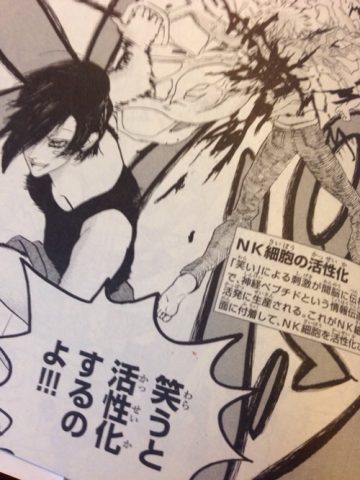
Source: Cells at Work! © Akane Shimizu/Kodansha, Aniplex, David Production
Laughter stimulates NK cells. Conversely, stress weakens them.
Gothic Lolita Fashion in the Past

Source: Cells at Work! © Akane Shimizu/Kodansha, Aniplex, davidproduction
According to an album owned by Dendritic Cell, NK Cell used to wear Gothic Lolita fashion. Apparently, it's such a dark past that NK Cell would go crazy the moment she saw her, since her appearance was so completely different from her current one.
13. M Cells
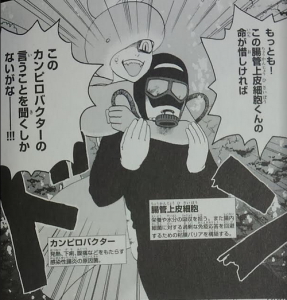
Source: Cells at Work! © Shimizu Akane/Kodansha, Aniplex, David Production
M cells exist in the intestines and manage Peyer's patches. They have a dapper appearance, and when bad bacteria run rampant in the intestines, they lure them into the Peyer's patches, eliminating them all in one fell swoop.
14. Hair Matrix Cells
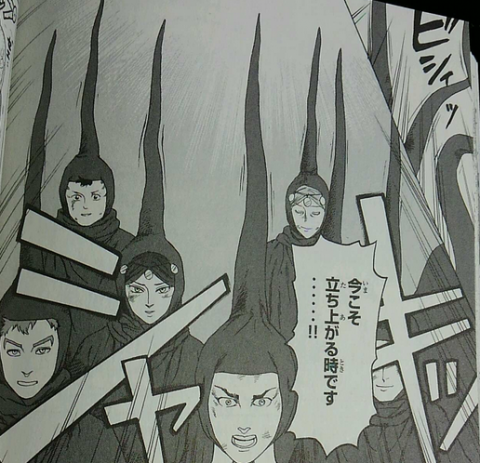
Source: Cells at Work! © Akane Shimizu/Kodansha, Aniplex, David Production
Hair matrix cells produce body hair and have the appearance of a young boy. When they were threatened with being taken over by acne bacteria, they courageously fought back alongside white blood cells.
15. Cell

Source: Cells at Work! © Akane Shimizu/Kodansha, Aniplex, David Production
Inside the body, they exist like ordinary citizens, wearing T-shirts with the word "Cell" written on them. They receive oxygen and nutrients from the Sekke-class cells, and undergo repeated cell division.
Tired of a boring daily routine?

Source: Cells at Work! © Shimizu Akane/Kodansha, Aniplex, davidproduction
Compared to immune system cells that eliminate bacteria and red blood cells that transport them, cells that simply repeat cell division in their rooms sometimes tire of their monotonous daily lives. Meanwhile, they sometimes have to deal with unusual visitors like rhinoviruses and lactic acid bacteria.
16. Beneficial Bacteria
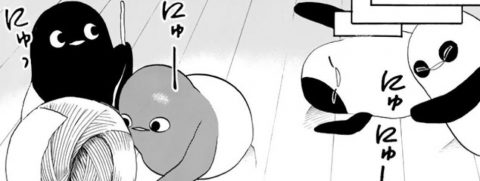
Source: Cells at Work! © Akane Shimizu/Kodansha, Aniplex, David Production
Beneficial bacteria refer to bacteria that are beneficial to humans. While harmful bacteria are eliminated by white blood cells, beneficial bacteria coexist with the body's cells.
Lactic Acid Bacteria

Source: Cells at Work! © Akane Shimizu/Kodansha, Aniplex, David Production
These beneficial bacteria are known for their adorable appearance and their cry of "new." They are essential for good health, as they fight off harmful bacteria and enjoy eating purines.
17. Pathogens
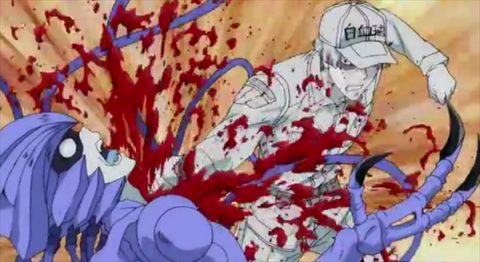
Source: Cells at Work! © Akane Shimizu/Kodansha, Aniplex, David Production
Cells at Work! doesn't just feature cells. Sometimes, bacteria and viruses invade the body.
Pneumococcus
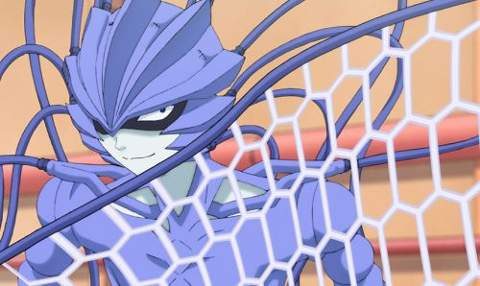
Source: Cells at Work! © Shimizu Akane/Kodansha, Aniplex, David Production
This bacterium, which appears in the first episode, causes pneumonia. It targets the protagonist's red blood cells because it invades the alveoli and destroys them. They cornered the red blood cells by sneaking into the luggage they were carrying, but they were found by the white blood cells and guided down to the bronchi, where they were excreted from the body in a sneeze. It's hard to deny that they didn't do enough research into the inside of the body.
Cedar Pollen Allergen

Source: Cells at Work ©Shimizu Akane/Kodansha, Aniplex, davidproduction
It is a protein found inside cedar pollen, which invades the body during the pollen season. Although they do not attack you in particular, when cells in the immune system react, they can cause an allergic reaction. In the end, he was defeated by steroids.
Influenza virus
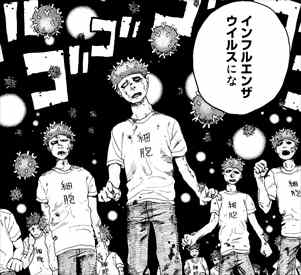
Source: Cells at Work ©Shimizu Akane/Kodansha, Aniplex, davidproduction
It has the habit of killing cells and turning them into zombies. It is also a troublesome opponent, as antigenic mutations prevent the previous antibodies from being used.
Staphylococcus aureus
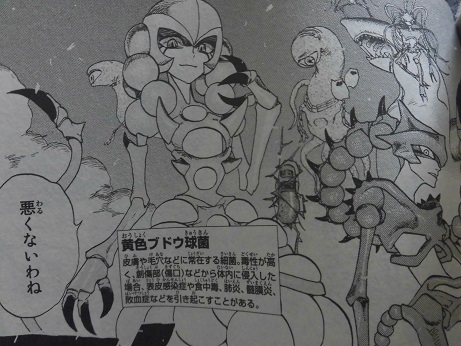
Source: Cells at Work ©Shimizu Akane/Kodansha, Aniplex, davidproduction
It is a bacteria that has invaded through a scratch. It is a bacteria that can also cause tetanus. However, the situation was reversed by fine plays in which platelets blocked the wound, and the situation was defeated.
Anisakis

Source: Cells at Work ©Shimizu Akane/Kodansha, Aniplex, davidproduction
Parasites that invaded the body were eating away at the stomach wall and were going wild. It was raging, but was defeated by eosinophils that are resistant to parasites.
Dengue virus
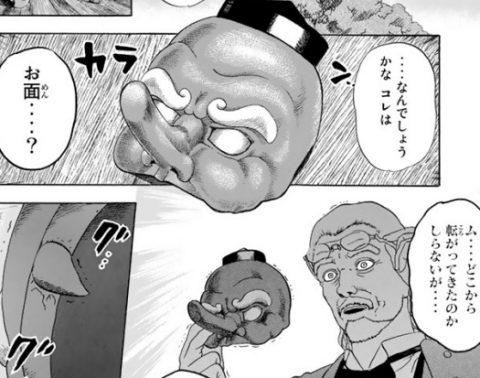
Source: Cells at Work ©Shimizu Akane/Kodansha, Aniplex, davidproduction
It is a virus that invades mosquitoes. It has the shape of a tengu mask, and when it was infected with Langerhans cells, it looked like Dio who appeared in JoJo.
Cancer cells

Source: Cells at Work ©Shimizu Akane/Kodansha, Aniplex, davidproduction
These are cells that are born during cell division due to abnormalities in genes. By multiplying infinitely, it takes over the organs in the body.
Questioning the meaning of being born

Source: Cells at Work ©Shimizu Akane/Kodansha, Aniplex, davidproduction
Although cancer cells are an abomination to the body, they were not originally born to destroy the body, and for cancer cells, they are unreasonably targeted for life, and they question the meaning of their birth.
Summary

Source: Cells at Work © Shimizu Akane/Kodansha, Aniplex, davidproduction
Just as all kinds of cells exist within the human body, "Cells at Work" feature many unique characters. Good and bad things appear for humans, creating a variety of dramas. Imagine this kind of thing happening within your body, but it's hard to understand, but it makes you want to be careful about your health.



